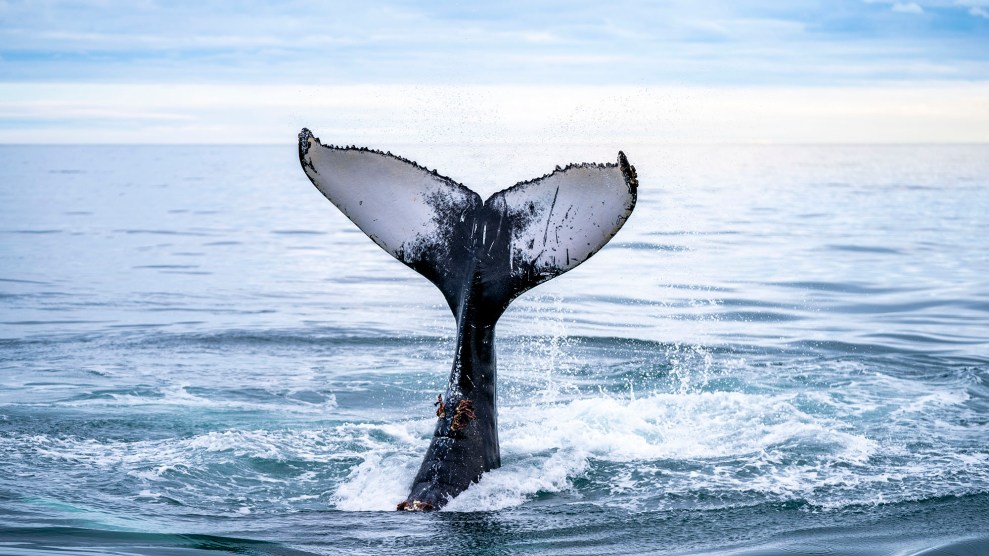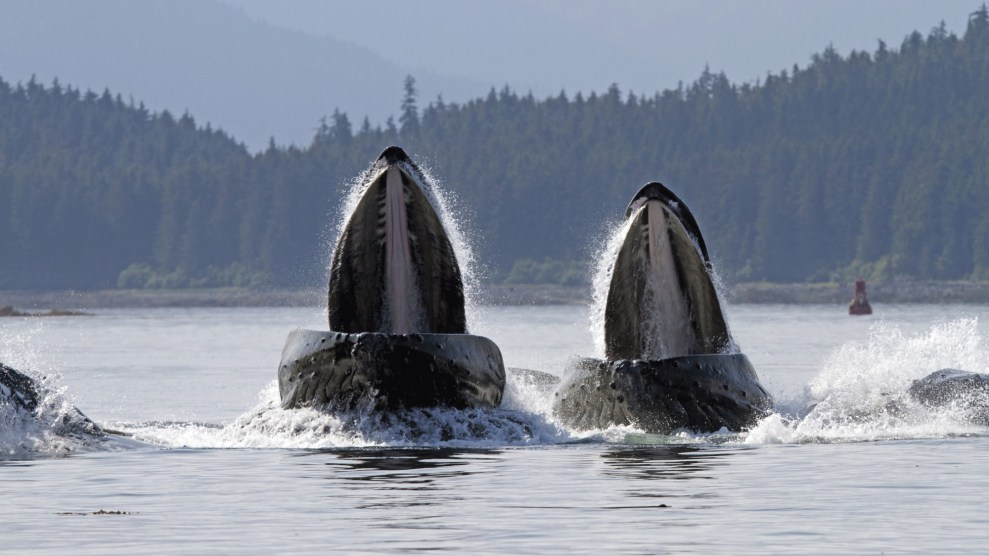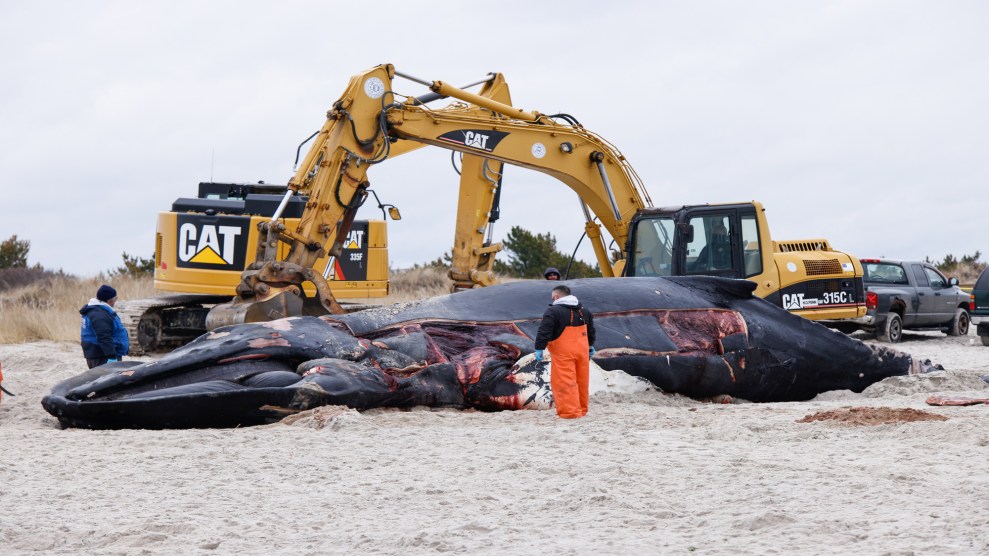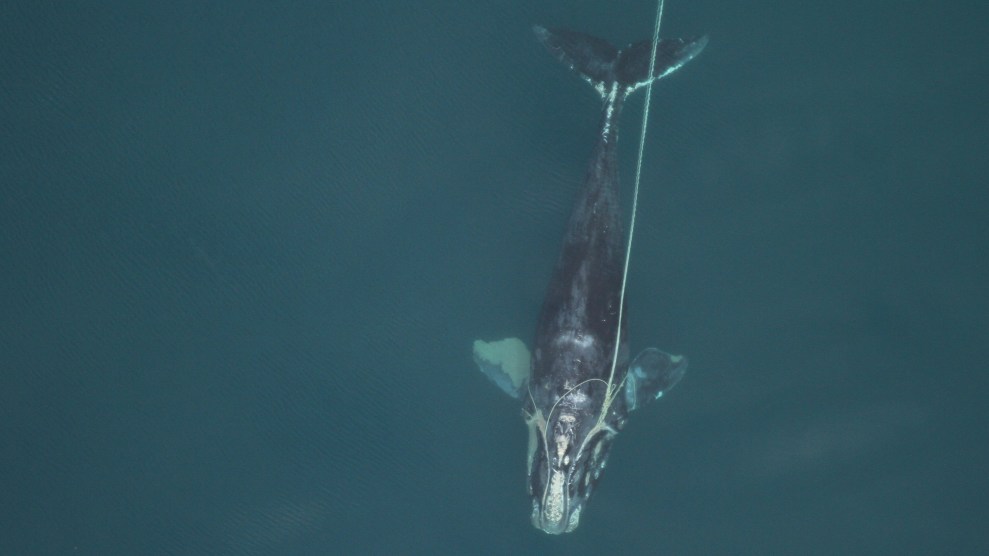
The tail of a 40 ton humpback in Svalbard, Norway in September, 2024.Media Drum World/Zuma
This story was originally published by the Guardian and is reproduced here as part of the Climate Desk collaboration.
From the moment that the biologist Heike Vester presses play, the sound of the static of the fjord fills the room. First comes the constant, steady rumbling of a boat engine. Then, every eight seconds, like a foreboding bass drum, comes the explosion of seismic airguns—extremely loud blasts used in oil and gas exploration that can travel vast distances underwater.
And finally, dancing above it all—and at times drowned out by it—are the soaring vocalizations of whales.
“Here, we have sperm whales clicking, pilot whales, and seismic airguns,” Vester says. During another recording playback, she points out the sound of a tourist boat’s gears shifting as it follows a group of feeding orcas.
Suddenly, as the engine sound becomes overwhelmingly loud, the whales’ calls become almost inaudibly faint. “It really affects their feeding,” she says. “As soon as there’s boat noise, they can’t feed any more. Whale-watchers should be aware of that.”
These underwater recordings, playing from Vester’s laptop at her home near Bodø, in the Norwegian Arctic Circle, are among hundreds she has made over decades in Vestfjorden.
Every year from April to October, whenever the weather allows, she lies for hours in a little boat with headphones on, listening to what her hydrophone picks up from 20 meters below the surface.
“It’s not just a masking of the communication. It’s also blinding their sensory organ of seeing underwater.”
The fjord, which is passed by the Gulf Stream coming up from Scotland, is visited by orcas, minke, humpback, sperm, and long-finned pilot whales. Blue whales have recently made a return.
But noise pollution now threatens all that, she says. It comes from cruise liners and tourist boats (many of which do not turn off their engines even when whale-watching), cargo ships, oil and gas exploration, and the military—along with issues posed by commercial fishing nets and pollution—and is growing in frequency and volume, she says.
Unlike the majority of humans, who see with their eyes, in the darkness of the ocean whales and dolphins see with sound. It is like going into a dark room and scanning the room with a torch, she says, only for somebody to suddenly turn on a big light. “You get blinded. And that’s how it is for the whales with noise—they get blinded.”
“It’s not just a masking of the communication,” Vester says. “It’s also blinding their sensory organ of seeing underwater.”
There are a number of studies that have looked at the impact of loud noises on marine life, in particular on whales. A study in 2022 found narwhals disturbed by seismic airguns changed their behaviour in a way that could affect their ability to forage.
It has also been proposed that human-made underwater sounds could be a contributory factor in mass whale strandings, such as the one seen in Scotland in July, when 77 pilot whales died on a beach.
Vester’s love of the mammals partly stems from her interest in matrilineal societies. “They live together in a very social way,” she says. “Studying social behaviour is very interesting, it’s very complex, and so is the vocal communication.
“The whales now live in a soundscape that is full of noise.”
“There’s this theory that the more complex a social organization, the more complex its vocal communication will be. There’s a connection, and that’s why I love to study them.”
Outside, on the rocks, three of her interns are dissecting a dead harbour porpoise by torchlight in driving rain. All summer she saw the calf swimming in the water with its mother, but this morning she found it dead on the beach. The six-month-old looks like it was killed in fishing nets, as “bycatch.”
Vester, who started her organization, Ocean Sounds, in 2005 and has been studying the seas off Vestfjorden since 1998, said noise pollution has been a long-running issue but in the last two decades has become significantly worse.
“The noise level in Vestfjorden has increased dramatically,” she says. “Now there’s hardly a place or a day when I don’t hear boat noise or shipping noise. The whales now live in a soundscape that is full of noise.”
In the summer, it never gets dark, so the noise goes on all night. “It’s nonstop, 24 hours.” Interest in deep-sea mining is growing globally and though it is likely to be far from Bodø, Vester fears that once they start there will be no stopping it.
Exploration is already causing damage to plankton, which is food for blue whales among other marine animals. “Every time a seismic airgun goes off, it kills zooplankton in a radius of 1.2 kilometers [three-quarters of a mile],” she says. “So they produce a death zone.”
Despite this, she says, blue whales are increasing in number in the North Atlantic—including in Vestfjorden. After being stuck in Germany during the pandemic, Vester was amazed on her return in 2022 to find a blue whale in the fjord. “I couldn’t believe my eyes. I never expected it.”
The species was hunted to the verge of extinction until it was protected in 1966, though it remains endangered today. There has been an increase in sightings in Svalbard and the north-east Atlantic population has increased since hunting stopped, according to the Norwegian Polar Institute. The summer range of the blue whale is also thought to be moving northwards.
“In a positive scenario, we can say there are more blue whales, the population is bouncing back and that means they spread out again, they go back to their traditional feeding grounds, which is in Vestfjorden as well,” says Vester.
But, she adds, there are many less obvious threats to its survival, including the impact of seismic surveys on plankton and noise pollution, on which there are currently no rules.
The Norwegian Offshore Directorate, the government agency that regulates oil exploration, says the Lofoten islands and fjords are protected from any commercial geophysical activity, but Vester says even if it is outside the protected area, the impact is still felt inside the fjord.
She says that some of the measures that could be taken include reducing the number of vessels in the water to cut noise and the amount of time that boats can be near whales, as well as developing silent boats.
Unlike plastic and chemical waste, acting on light and noise pollution is something that can be done instantly, she says. “Switch it off and it’s gone.”
















